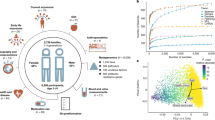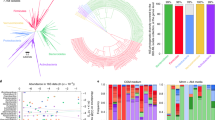Abstract
A primary goal of the Human Microbiome Project (HMP) was to provide a reference collection of 16S ribosomal RNA gene sequences collected from sites across the human body that would allow microbiologists to better associate changes in the microbiome with changes in health1. The HMP Consortium has reported the structure and function of the human microbiome in 300 healthy adults at 18 body sites from a single time point2,3. Using additional data collected over the course of 12–18 months, we used Dirichlet multinomial mixture models4 to partition the data into community types for each body site and made three important observations. First, there were strong associations between whether individuals had been breastfed as an infant, their gender, and their level of education with their community types at several body sites. Second, although the specific taxonomic compositions of the oral and gut microbiomes were different, the community types observed at these sites were predictive of each other. Finally, over the course of the sampling period, the community types from sites within the oral cavity were the least stable, whereas those in the vagina and gut were the most stable. Our results demonstrate that even with the considerable intra- and interpersonal variation in the human microbiome, this variation can be partitioned into community types that are predictive of each other and are probably the result of life-history characteristics. Understanding the diversity of community types and the mechanisms that result in an individual having a particular type or changing types, will allow us to use their community types to assess disease risk and to personalize therapies.
This is a preview of subscription content, access via your institution
Access options
Subscribe to this journal
Receive 51 print issues and online access
$199.00 per year
only $3.90 per issue
Buy this article
- Purchase on Springer Link
- Instant access to full article PDF
Prices may be subject to local taxes which are calculated during checkout



Similar content being viewed by others
References
Peterson, J. et al. The NIH Human Microbiome Project. Genome Res. 19, 2317–2323 (2009)
The Human Microboime Consortium. A framework for human microbiome research. Nature 486, 215–221 (2012)
The Human Microboime Consortium. Structure, function and diversity of the healthy human microbiome. Nature 486, 207–214 (2012)
Holmes, I., Harris, K. & Quince, C. Dirichlet multinomial mixtures: generative models for microbial metagenomics. PLoS ONE 7, e30126 (2012)
Aagaard, K. et al. The Human Microbiome Project strategy for comprehensive sampling of the human microbiome and why it matters. FASEB J. 27, 1012–1022 (2013)
Turnbaugh, P. J. et al. A core gut microbiome in obese and lean twins. Nature 457, 480–484 (2009)
Costello, E. K. et al. Bacterial community variation in human body habitats across space and time. Science 326, 1694–1697 (2009)
Koren, O. et al. A guide to enterotypes across the human body: meta-analysis of microbial community structures in human microbiome datasets. PLOS Comput. Biol. 9, e1002863 (2013)
Arumugam, M. et al. Enterotypes of the human gut microbiome. Nature 473, 174–180 (2011)
Wu, G. D. et al. Linking long-term dietary patterns with gut microbial enterotypes. Science 334, 105–108 (2011)
Quince, C. et al. The impact of Crohn’s disease genes on healthy human gut microbiota: a pilot study. Gut 62, 952–954 (2013)
Brotman, R. M. et al. Association between Trichomonas vaginalis and vaginal bacterial community composition among reproductive-age women. Sex. Transm. Dis. 39, 807–812 (2012)
Gajer, P. et al. Temporal dynamics of the human vaginal microbiota. Sci. Transl. Med. 4, 132ra152 (2012)
Ravel, J. et al. Vaginal microbiome of reproductive-age women. Proc. Natl Acad. Sci. USA 108 (suppl. 1). 4680–4687 (2011)
Statnikov, A. et al. Microbiomic signatures of psoriasis: feasibility and methodology comparison. Sci. Rep. 3, 2620 (2013)
Arumugam, M. et al. Addendum: Enterotypes of the human gut microbiome. Nature 506, 516 (2014)
Moeller, A. H. et al. Chimpanzees and humans harbour compositionally similar gut enterotypes. Nature Commun. 3, 1179 (2012)
Palmer, C., Bik, E. M., Digiulio, D. B., Relman, D. A. & Brown, P. O. Development of the human infant intestinal microbiota. PLoS Biol. 5, e177 (2007)
Koenig, J. E. et al. Succession of microbial consortia in the developing infant gut microbiome. Proc. Natl Acad. Sci. USA 108 (suppl. 1). 4578–4585 (2011)
Pantoja-Feliciano, I. G. et al. Biphasic assembly of the murine intestinal microbiota during early development. ISME J. 7, 1112–1115 (2013)
Fierer, N., Hamady, M., Lauber, C. L. & Knight, R. The influence of sex, handedness, and washing on the diversity of hand surface bacteria. Proc. Natl Acad. Sci. USA 105, 17994–17999 (2008)
Markle, J. G. et al. Sex differences in the gut microbiome drive hormone-dependent regulation of autoimmunity. Science 339, 1084–1088 (2013)
Ma, B., Forney, L. J. & Ravel, J. Vaginal microbiome: rethinking health and disease. Annu. Rev. Microbiol. 66, 371–389 (2012)
Schloss, P. D. et al. Introducing mothur: Open-source, platform-independent, community-supported software for describing and comparing microbial communities. Appl. Environ. Microbiol. 75, 7537–7541 (2009)
Schloss, P. D., Gevers, D. & Westcott, S. L. Reducing the effects of PCR amplification and sequencing artifacts on 16S rRNA-based studies. PLoS ONE 6, e27310 (2011)
Jumpstart Consortium Human Microbiome Project Data Generation Working Group. Evaluation of 16S rDNA-based community profiling for human microbiome research. PLoS ONE 7, e39315 (2012)
Quince, C., Lanzen, A., Davenport, R. J. & Turnbaugh, P. J. Removing noise from pyrosequenced amplicons. BMC Bioinform. 12, 38 (2011)
Schloss, P. D. A high-throughput DNA sequence aligner for microbial ecology studies. PLoS ONE 4, e8230 (2009)
Schloss, P. D. Secondary structure improves OTU assignments of 16S rRNA gene sequences. ISME J. 7, 457–460 (2013)
Pruesse, E. et al. SILVA: a comprehensive online resource for quality checked and aligned ribosomal RNA sequence data compatible with ARB. Nucleic Acids Res. 35, 7188–7196 (2007)
Edgar, R. C., Haas, B. J., Clemente, J. C., Quince, C. & Knight, R. UCHIME improves sensitivity and speed of chimera detection. Bioinformatics 27, 2194–2200 (2011)
Wang, Q., Garrity, G. M., Tiedje, J. M. & Cole, J. R. Naive Bayesian classifier for rapid assignment of rRNA sequences into the new bacterial taxonomy. Appl. Environ. Microbiol. 73, 5261–5267 (2007)
Acknowledgements
We thank J. Crabtree of the HMP Data Analysis and Coordination Center for his assistance in obtaining the sequencing and metadata files. The analysis described in this study was supported by grants from the National Institutes of Health (R01HG005975, R01GM099514 and P30DK034933).
Author information
Authors and Affiliations
Contributions
T.D. and P.D.S. designed and executed the analysis and prepared the manuscript.
Corresponding author
Ethics declarations
Competing interests
The authors declare no competing financial interests.
Extended data figures and tables
Extended Data Figure 1 Comparison of community type assignments for non-metric dimensional scaling (NMDS) ordination of Jensen–Shannon divergence values between stool samples using DMM (a) and PAM-based clustering (b).
The stress computed for this ordination was 0.19 and the R2 between the input distance matrix and the distance matrix calculated between the points in the ordination was 0.90.
Extended Data Figure 2 The frequency of community types for body sites where there was a significant association with the subject’s gender.
a–c, Percentage of female and male tongue communities that affiliated with each of the tongue (a; n = 288 unique individuals; median P = 2 × 10−3), right retroauricular crease (b; n = 268 unique individuals; median P = 9 × 10−5) and right antecubital fossa community types (c; n = 136 unique individuals; median P = 3 × 10−5).
Extended Data Figure 3 The frequency of vaginal community types among women with and without a college degree.
a–c, Percentage of women with and without a college degree whose vaginal communities affiliated with the vaginal introitus (a; n = 74 unique individuals; median P = 2 × 10−3), mid-vagina (b; n = 64 unique individuals; median P = 8 × 10−4) and posterior fornix (c; n = 61 unique individuals; median P = 4 × 10−4) community types.
Supplementary information
Supplementary Information
This file contains Supplementary Text and additional references. (PDF 218 kb)
Rights and permissions
About this article
Cite this article
Ding, T., Schloss, P. Dynamics and associations of microbial community types across the human body. Nature 509, 357–360 (2014). https://doi.org/10.1038/nature13178
Received:
Accepted:
Published:
Issue Date:
DOI: https://doi.org/10.1038/nature13178
This article is cited by
-
Impact of perinatal HIV exposure and infection on salivary properties among Nigerian children
BMC Oral Health (2024)
-
Symbiotic microbiome Staphylococcus epidermidis restricts IL-33 production in allergic nasal epithelium via limiting the cellular necroptosis
BMC Microbiology (2023)
-
Core gut microbes Cloacibacterium and Aeromonas associated with different gastropod species could be persistently transmitted across multiple generations
Microbiome (2023)
-
Genetic hypogonadal mouse model reveals niche-specific influence of reproductive axis and sex on intestinal microbial communities
Biology of Sex Differences (2023)
-
Human milk oligosaccharides modulate the intestinal microbiome of healthy adults
Scientific Reports (2023)
Comments
By submitting a comment you agree to abide by our Terms and Community Guidelines. If you find something abusive or that does not comply with our terms or guidelines please flag it as inappropriate.



